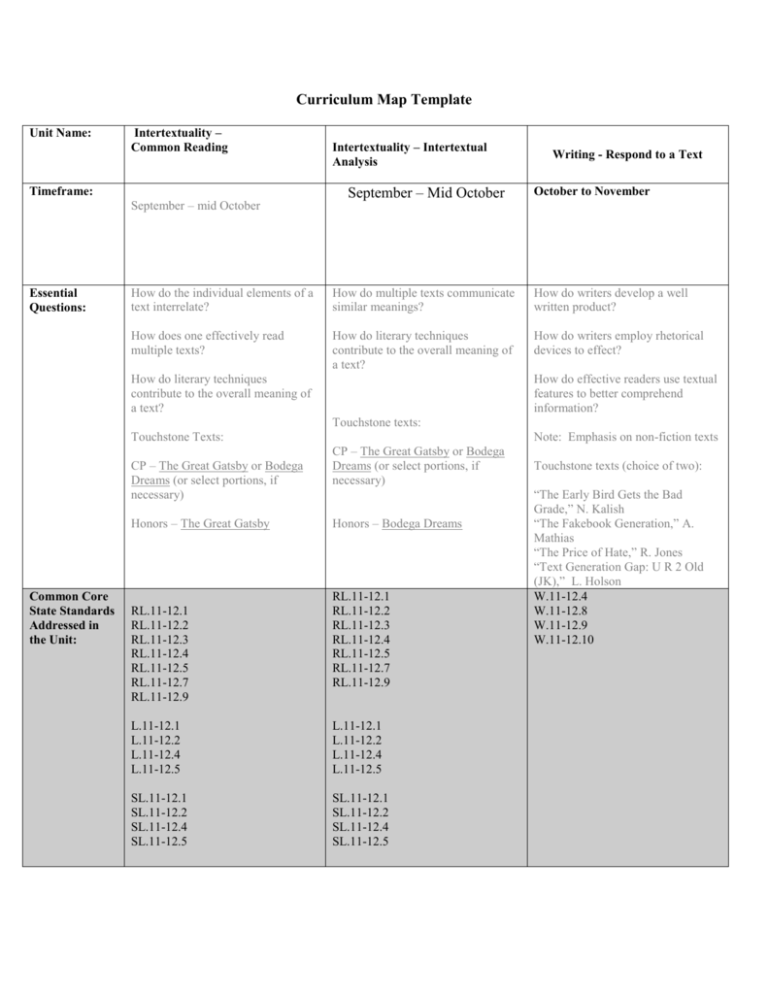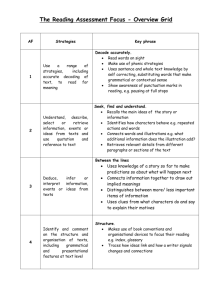Grade 11 Language Arts
advertisement

Curriculum Map Template Unit Name: Intertextuality – Common Reading Timeframe: September – mid October Essential Questions: Intertextuality – Intertextual Analysis September – Mid October Writing - Respond to a Text October to November How do the individual elements of a text interrelate? How do multiple texts communicate similar meanings? How do writers develop a well written product? How does one effectively read multiple texts? How do literary techniques contribute to the overall meaning of a text? How do writers employ rhetorical devices to effect? How do literary techniques contribute to the overall meaning of a text? How do effective readers use textual features to better comprehend information? Touchstone texts: Touchstone Texts: CP – The Great Gatsby or Bodega Dreams (or select portions, if necessary) Honors – The Great Gatsby Common Core State Standards Addressed in the Unit: RL.11-12.1 RL.11-12.2 RL.11-12.3 RL.11-12.4 RL.11-12.5 RL.11-12.7 RL.11-12.9 Note: Emphasis on non-fiction texts CP – The Great Gatsby or Bodega Dreams (or select portions, if necessary) Honors – Bodega Dreams RL.11-12.1 RL.11-12.2 RL.11-12.3 RL.11-12.4 RL.11-12.5 RL.11-12.7 RL.11-12.9 L.11-12.1 L.11-12.2 L.11-12.4 L.11-12.5 L.11-12.1 L.11-12.2 L.11-12.4 L.11-12.5 SL.11-12.1 SL.11-12.2 SL.11-12.4 SL.11-12.5 SL.11-12.1 SL.11-12.2 SL.11-12.4 SL.11-12.5 Touchstone texts (choice of two): “The Early Bird Gets the Bad Grade,” N. Kalish “The Fakebook Generation,” A. Mathias “The Price of Hate,” R. Jones “Text Generation Gap: U R 2 Old (JK),” L. Holson W.11-12.4 W.11-12.8 W.11-12.9 W.11-12.10 Common Formal Assessment: Using your understanding of intertextuality, create a text (PowerPoint, MovieMaker, iMovie) comparing two works, one classical (a painting or sculpture, piece of “serious” music, critically acclaimed film, established piece of literature) with a contemporary piece from the same or a similar genre, though it must be clear that you know the characteristics of the genre(s). Curriculum Map Template Grade 11 Unit II Using Definition to Frame Reading Unit Name: Using Definition to Frame Reading and Writing – Common Reading Timeframe: Using Definition to Frame Reading and Writing – Literature Circles Writing – New Historicism November - December December - January November - December Essential Questions: How are time period and genre reflected in the text of choice? How are texts indicative of an overall social reality? Touchstone texts: Modernism and Postmodernism (minimum three texts from each category, with representation from multiple genres). Modernist Ernest Hemingway John Steinbeck William Faulkner Flannery O’Connor Joyce Carol Oates William Carlos Williams ee cummings W.H. Auden Wallace Stevens E.A. Robinson W. B. Yeats W. Owens Postmodernist Alice Walker Paul Aster Raymond Carver A. MacLeish .How do multiple texts communicate a similar meaning? Literature Circle/College Prep: Students apply definitions of movements to reading of their choice. Touchstone texts: Old School, T. Wolff Ami I Blue, M. Bauer Fallen Angels, W. D. Meyers Quaking, K. Erskine The Body of Christopher Creed, C. Plum-Ucci After the First Death, R. Cormier No Exit, J-P Sartre Touchstone texts: Author Study/Honors: Students apply definitions of movements to multiple texts from single author of choice Thorton Wilder (Our Town, Skin of Our Teeth) Ernest Hemingway (In Our Time, The Sun Also Rises) William Faulkner (The Sound and the Fury, “The Bear”) How are texts indicative of an overall social reality? How do students come to a better understanding of texts utilizing the lens of New Historicism? How does one write a literaturebased research paper? Note: Research-based using MLA format. John Updike Tim O’Brien Ernest Gaines A. Ginsberg J. Kerouac S. Plath R. Pinsky C. Wright Billy Collins Common Core State Standards Addressed in the Unit: RL.11-12.1 RL .11-12.2 RL. 11-12.4 RL.11-12.9 L.11-12.3 L.11-12.4 L.11-12.5 Tennessee Williams (A Streetcar Named Desire, The Glass Menagerie) Arthur Miller (The Crucible, Death of a Salesman) RL.11-12.1 RL.11-12.2 RL.11-12.4 L.11-12.3 L.11-12.4 L.11-12.5 W.11-12.1 W.11-12.2 W.11-12.4 W.11-12.5 W.11-12.9 RI.11-12.1 RI.11-12.4 RI.11-12.5 RI.11-12.6 SL.11-12.1 SL.11-12.2 SL.11-12.4 SL.11-12.5 Common Formal Assessment: Group: Using your understanding of literary traditions, create a lesson for the class that defines a past literary tradition using a teacher-assigned text unique to your group, and then evaluates the relationship of that tradition to a contemporary literary tradition using a text of your group’s choice. Curriculum Map Template Unit Name: Inquiry and Research Synthesizing Research Writing and Revising Research Paper Timeframe: Midterm-early February February-early March March Essential Questions: How do I write my way into a subject? How do I think about myself as a researcher and as a writer? How do I read research? How do writers critically filter works to support a research topic? Note: Use of MLA format required. How do writers develop a wellwritten product? How does research become writing? How do writers critically select works to support a research topic? How does the written product change and evolve in response to feedback? How do writers select appropriate print and electronic media for research and evaluate the quality of the information received? Common Core State Standards Addressed in the Unit: W.11-12.1.b W.11-12.2.a W.11-12.3.a W.11-12.8 W.11-12.10 RI.11-12.7 W.11-12.2.b W.11-12.7 W.11-12.8 W.11-12.10 SL.11-12.2 W.11-12.1.b W.11-12.1.c W.11-12.1.d W.11-12.1.e W.11-12.2.b W.11-12.2.c W.11-12.2.e W.11-12.2.f W.11-12.4 W.11-12.5 W.11-12.6 W.11-12.10 SL.11-12.4 L.11-12.1.a L.11-12.1.b L.11-12.2.a L.11-12.2.b L.11-12.3.a L.11-12.6 Common Formal Assessment: Individual: Student presents abstract/”snapshot” of research process/final paper. Abstract/”snapshot” should include substantive reflection on concrete aspects of process as well as product. Curriculum Map Template Unit Name: The Expression of Self in Writing: Common Reading The Expression of Self in Writing: Literature Circles The Expression of Self in Writing: Personal Writing Timeframe: April Essential Questions: May June How do readers express individuality in texts? How do readers express individuality in texts? How do good writers express themselves? How do writers use literary devices to affect emotions and understanding? How do writers use literary devices to affect emotions and understanding? How does process shape the writer’s product? How do readers analyze an author’s use of words to create tone and mood, and how an author’s choice of words advances the theme of the work? How do readers analyze an author‘s use of words to create tone and mood, and how an author’s choice of words advances the theme of the work? Selections from Common Ground, The Norton Sampler, and other personal narrative compilations. Literature Circle texts: A Boys’ Life, T. Wolff Manchild in the Promised Land, C. Brown Who Killed My Daughter?, L. Duncan The Autobiography of Malcolm X, Malcolm X Down These Mean Streets, P. Thomas Surely You’re Joking, Mr. Feynman, R. Feynman The Color Of Water, J. McBride Funny in Farsi: A Memoir of Growing Up Iranian in America, F. Dumas Pedro and Me, J. Winnick Lost in Translation, E. Hoffman When I Was Puerto Rican, E. Santiago The Woman Warrior, M. Hong Kingston Hunger of Memory, R. Rodriguez Common Core State Standards Addressed in the Unit: RL.11-12.1 RL.11-12.2 RL.11-12.3 RL.11-12.4 RL.11-12.5 RL.11-12.6 RL.11-12.1 RL.11-12.2 RL.11-12.3 RL.11-12.4 RL.11-12.5 RL.11-12.6 SL.11-12.1.a SL.11-12.1.b SL.11-12.1.c SL.11-12.1.d SL.11-12.3 W.11-12.3.a W.11-12.3.b W.11-12.3.c W.11-12.3.d W.11-12.3.e W.11-12.4 W.11-12.5 W.11-12.6 SL.11-12.4 SL.11-12.5 SL.11-12.6 L.11-12.1.a L.11-12.1.b L.11-12.2.a L.11-12.2.b L.11-12.3.a Common Formal Assessment: Individual: Creation and presentation of an electronic portfolio that includes excerpts from student written personal narrative, along with images, film, and sound (including voice-over narration) that most clearly demonstrate the theme and tone/mood of the narrative.







